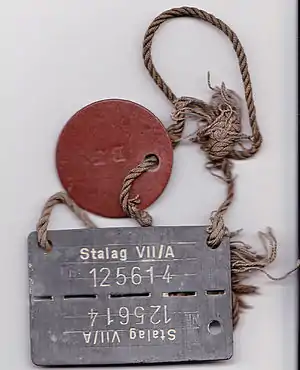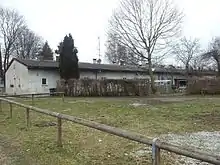Stalag VII-A
Stalag VII-A (in full: Kriegsgefangenen-Mannschafts-Stammlager VII-A) was the largest prisoner-of-war camp in Nazi Germany during World War II, located just north of the town of Moosburg in southern Bavaria. The camp covered an area of 35 hectares (86 acres). It served also as a transit camp through which prisoners, including officers, were processed on their way to other camps. At some time during the war, prisoners from every nation fighting against Germany passed through it. At the time of its liberation on 29 April 1945, there were 76,248 prisoners in the main camp and 40,000 or more in Arbeitskommando working in factories, repairing railroads or on farms.[1][2][3]
| Stalag VII-A | |
|---|---|
| Moosburg, Bavaria | |
 ID tag as worn by POWs. Name and service number are on the brown disc. | |
 Stalag VII-A | |
| Coordinates | 48.4887°N 11.9435°E |
| Type | Prisoner-of-war camp |
| Site information | |
| Controlled by | |
| Site history | |
| In use | 1939–1945 |
Camp history
The camp was opened in September 1939[4] and was designed to house up to 10,000 Polish prisoners from the German September 1939 offensive. The first prisoners arrived while the wooden barracks were under construction and for several weeks lived in tents.[1]
British, French, Belgian and Dutch soldiers taken prisoner during the Battle of France started arriving in May 1940. Many were transferred to other camps, but close to 40,000 French remained at Stalag VII-A throughout the war.
British, Greek and Yugoslavian prisoners arrived from the Balkans Campaign in May and June 1941. A few months later Soviet prisoners started arriving, mostly officers. At the end of the war there were 27 Soviet generals in the prison.
More British Commonwealth and Polish prisoners came from the North African campaign and the offensive against the Italian-held islands in the Mediterranean. They were brought from Italian POW camps after the Armistice with Italy in September 1943, including many who escaped at that time and were recaptured. Italian soldiers were also imprisoned.
The first American arrivals came after the Tunisia Campaign in December 1942, and the Italian Campaign in 1943. Large numbers of Americans were captured in the Battle of the Bulge in December 1944.
Among the last arrivals were officers from Stalag Luft III who had been force-marched from Sagan in Silesia (now Żagań), Poland).[5] They arrived on 2 February 1945. They were followed by more prisoners marched from other camps threatened by the advancing Soviets, including American officers who had been marched from Oflag 64 in Szubin, via Oflag XIII-B, under their senior officer Lt.Col. Paul Goode.
During the 5½ years, about 1,000 prisoners died at the camp, over 800 of them Soviets. They were buried in a cemetery in Oberreit, south of Moosburg. Most died from illness, some from injuries during work.
On 1 August 1942 Major Karl August Meinel was shifted into the Führerreserve, because on 13 January 1942 he wrote a critical report to General Hermann Reinecke on the segregation and execution of Russian prisoners of war in Stalag VII-A by the Gestapo and the Sicherheitsdienst SD (security service) of the Reichsführer SS (Heinrich Himmler).[6]
Liberation
Stalag VII-A was captured on 29 April 1945 by Combat Command A of the 14th Armored Division. A German proposal for an armistice was rejected, followed by a short, uneven battle between the American tanks and retreating German soldiers for control of bridges across the Amper and Isar rivers. The German contingent included "remnants of the 17th SS Panzer Grenadier and 719th Infantry Divisions...which had no tanks or antitank guns, and were armed with only small arms, machine guns, mortars, and panzerfausts".[2] Large numbers surrendered, as did the camp's 240 guards. The American force learned of the existence of the camp and its approximate location only a few hours before the attack. Because so many Allied POWs were in the area, the U.S. artillery, a major factor in any attack, was ordered not to fire, and remained silent during the attack.[2] According to official German sources, there had been 76,248 prisoners at the camp in January 1945.[1]
Aftermath

After the liberation Stalag VII-A was turned into Civilian Internment Camp #6 for 12,000 German men and women suspected of criminal activity for the Nazi regime. Later the camp was turned into a new district of the town called Moosburg-Neustadt.[1] One of the old huts has been restored.
A memorial to inmates of Stalag VII-A was built. It is a fountain located in the center of Neustadt. It consists of four bas-reliefs created out of local stone by the French sculptor Antoniucci Volti while he was a prisoner in the camp.[7]
In 1958 the Oberreit cemetery was closed. 866 bodies were exhumed and reburied at the military cemetery in Schwabstadl near Landsberg. The bodies of 33 Italians were reburied at the Italian Memorial Cemetery near Munich. In 1982 the Moosburg City Council purchased a plot at the site of the old Oberreit cemetery and erected a wooden cross with a simple stone remembering the dead of Stalag VII-A.[8]
Notable prisoners
- Richard A. Radford
- Robert M. Polich Sr.[9]
- Derek Bond, M.C, Grenadier Guards
- John Allen Dixon Jr., later Chief Justice of the Louisiana Supreme Court[10]
- Alexander Jefferson
- Jack Hemingway
- Clifford L Eads (Bronze Star Recipient)[11]
- John Waddy
See also
- List of prisoner-of-war camps in Germany
- Stalag
- Karl von Eberstein - SS officer who helped fire Meinel after he objected to POW killings
- Gestapo - responsible for 'screening' POWs to be murdered
References
- "Stalag VII-A : History 1939-45". Moosburg Online. 2008. Retrieved 17 May 2019.
- Lankford, Jim (2011). "The 14th Armored Division and the Liberation of Stalag VIIA". Army History Center : Virtual Library. Archived from the original on 6 July 2010. Retrieved 17 May 2019.
- "Stalag VII-A Kommandos". Moosburg Online. 2011. Retrieved 17 May 2019.
- "POW camp Stalag VII-A : Brief history". Moosburg Online. 2011. Retrieved 17 May 2019.
- Petersen, Quentin Richard (2011). "The March : A Continuing Memoir". World War II Living Memorial. Retrieved 17 May 2019.
- Streim, Alfred (1982). Sowjetische Gefangene in Hitlers Vernichtungskrieg: Berichte und Dokumente, 1941-1945 [Soviet Prisoners in Hitler's War of Extermination : Reports and Documents, 1939-1945] (in German). Heidelberg: C. F. Müller Juristischer Verlag. pp. 41–44. ISBN 978-3-8114-2482-1.
- The Stalag fountain in memory of the Moosburg POW camp at Moosburg Online
- "Stalag VII A Cemetery : Oberreit Memorial". Thonstetten.de (in German). 2004. Retrieved 17 May 2019.
- Rofidal, K. (2011). "Red Leader On Fire". Minnesota Historical Society. Retrieved 17 May 2019.
- Jerry Byrd, "Chief Justice rules in favor of running", The Shreveport Journal (July 6, 1982), p. 1C.
- https://www.findagrave.com/memorial/203317503/clifford-lamar-eads
Walter 'Boots' Mayberry POW 3 months WW2
Further reading
- Bond, Derek, M.C., (1990) Steady, Old Man! Don't You Know There's a War On? Leo Cooper (Pen & Sword) ISBN 0-85052-046-0
- Dann, John (2018) A Welsh Uncle, Memories of Tom Morgan 1898–1957,ISBN 9-781784-565978
- Devaux, Roger (2007). Treize qu'ils étaient : la vie des prisonniers de guerre français chez les paysans de basse Bavière 1940-1945 [They Were Thirteen : The Lives of French prisoners of war among the peasants of Lower Bavaria, 1940-1945] (in French). ISBN 978-2-916062-51-8. Archived from the original on 2012-12-09.
External links
- Diaries by Sapper Roger Collinson RE whilst a prisoner of World War II, 1943 to 1945
- The Wartime Memories Project : Stalag 7A POW camp
- Stoker Harold Siddall, RN, captured on Crete and his life in Stalag VII-A